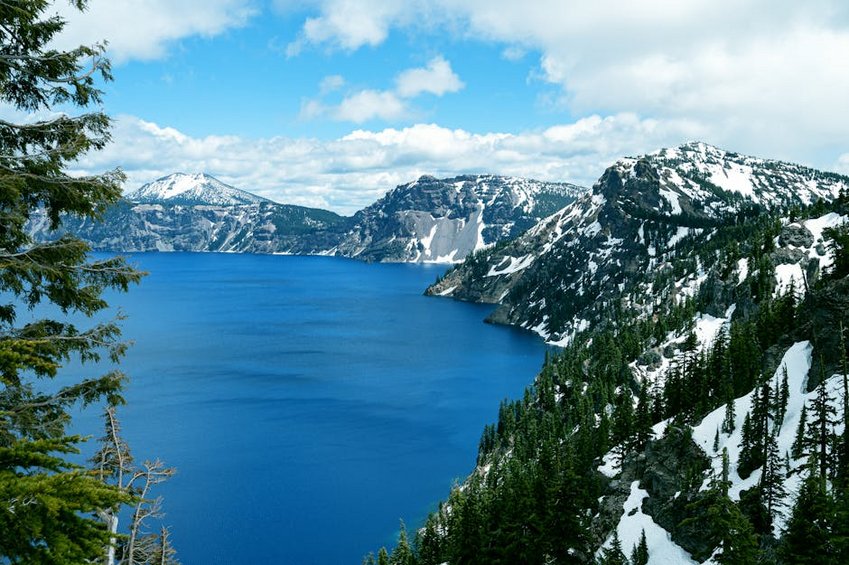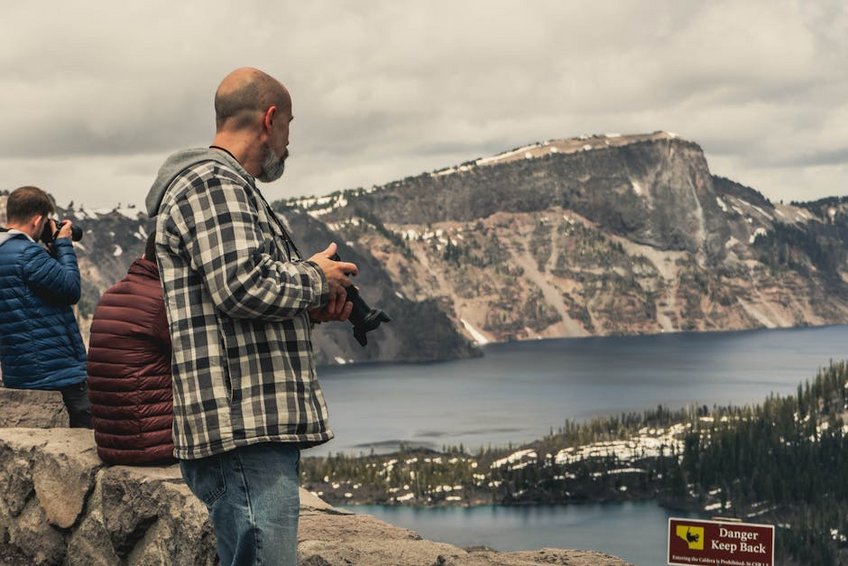Oregon Crater Lake Winter Blue: A Magical Frozen Wonderland
Imagine standing at the edge of one of America’s most stunning natural wonders, where the deepest lake in the United States transforms into a surreal winter paradise. The Oregon Crater Lake winter blue experience is unlike any other, with the lake’s vivid sapphire waters contrasting dramatically against pure white snowscapes. Formed over 7,700 years ago by the collapse of Mount Mazama, this volcanic caldera holds some of the clearest freshwater on Earth, creating that iconic intense blue hue that becomes even more mesmerizing in winter. You’ll find yourself surrounded by silent, snow-draped forests and crisp mountain air, with opportunities for snowshoeing, cross-country skiing, and simply soaking in the breathtaking views. Visiting during the colder months means fewer crowds, pristine landscapes, and a chance to witness the lake’s surface occasionally freezing along the edges, though it rarely freezes completely. This guide will walk you through everything from seasonal access and safety precautions to the best photography spots and cozy accommodations, ensuring your Oregon Crater Lake winter blue adventure becomes an unforgettable journey into nature’s frozen artistry.
Oregon Crater Lake Winter Blue – Essential Information
Before embarking on your winter adventure to Crater Lake, understanding the park’s unique characteristics and seasonal changes is crucial for a safe and enjoyable visit. The Oregon Crater Lake winter blue phenomenon occurs because the water’s exceptional clarity allows sunlight to penetrate deeply, scattering blue wavelengths and absorbing others, resulting in that stunning cobalt color. Winter brings heavy snowfall, with averages of 43 feet annually, completely transforming the landscape into a white wonderland. Park access changes significantly from November through April, with the North Entrance and Rim Drive typically closed due to snow, while the South Entrance remains open year-round, weather permitting. You’ll need to be prepared for rapidly changing conditions, including sudden snowstorms, limited services, and potential road closures. The park’s high elevation (around 6,000-8,000 feet) means thinner air and colder temperatures, often dipping below freezing, so proper clothing and equipment are non-negotiable. Rangers offer guided snowshoe walks during weekends, providing educational insights into the park’s geology and ecology while ensuring visitor safety in this challenging but rewarding environment.
Geological Formation and Winter Characteristics
- Crater Lake was formed by the catastrophic eruption of Mount Mazama approximately 7,700 years ago, creating the deepest lake in the United States at 1,943 feet, which contributes to its intense blue color year-round.
- During winter, the lake’s surface temperature hovers just above freezing, and while it rarely freezes completely due to its depth, you might see ice formations along the shoreline, enhancing the visual contrast.
- The surrounding caldera walls, composed of volcanic rock, become coated with snow and ice, creating dramatic scenery and potential hazards like avalanches in certain areas, so always check current conditions.
- Budget-friendly options include camping in nearby national forests (free or $10-20 per night), bringing your own food, and using annual park passes ($80 America the Beautiful Pass) for multiple visits, with total costs around $50-100 per day per person including gas and fees.
- Mid-range travelers might stay in motels in nearby towns like Fort Klamath ($80-150 per night), rent snowshoes or skis ($20-40 per day), and dine at local restaurants, budgeting $150-250 daily for a comfortable experience with guided activities.
- Luxury experiences involve staying at Crater Lake Lodge if open (winter rates $200-400 per night), private guided tours ($100-200 per person), and fine dining, with daily budgets of $300-500 per person for a premium winter adventure.
- Crater Lake National Park Official Website
- Travel Oregon Official Tourism Site
Park Operations and Winter Access Details
From November through April, Crater Lake National Park operates on a reduced schedule, with limited facilities open. The Steel Visitor Center remains accessible, providing maps, permits, and current weather updates, while the Rim Village Café and Gift Shop may have restricted hours. Road access is primarily through the South Entrance from Highway 62, with the North Entrance closed until late spring. You’ll find that the park plows roads to Rim Village and the headquarters area, but beyond that, travel is only possible on foot, skis, or snowshoes. The park charges an entrance fee of $30 per vehicle in winter (valid for seven days), with annual passes available. Rangers conduct regular patrols and offer safety briefings, especially since cell service is spotty throughout the park, making self-reliance and preparation essential for your Oregon Crater Lake winter blue exploration.

Oregon Crater Lake Winter Blue – Planning Your Trip
Planning your visit to experience the Oregon Crater Lake winter blue requires careful timing and preparation to make the most of this seasonal spectacle. You’ll want to consider factors like weather patterns, daylight hours, and your own comfort with winter activities. The park sees significantly fewer visitors from December to March, offering a more solitary and intimate experience with nature, but this also means limited services and potential challenges. I recommend checking the National Park Service website for current conditions at least a week before your trip and again the day of, as weather can change rapidly in the Cascade Mountains. Packing essential gear like tire chains, extra food and water, warm layers, and emergency supplies is not just advisable—it’s necessary for safety. If you’re new to winter travel, consider joining a guided tour or ranger-led activity to gain confidence and knowledge. Budgeting appropriately is key, as winter travel often involves additional costs for equipment rental, accommodation upgrades for heating, and potential for longer stays due to weather delays.
Best Time to Visit Oregon Crater Lake Winter Blue
The optimal window for experiencing the Oregon Crater Lake winter blue typically runs from late December through early March, when snowfall is heaviest and the landscape is at its most dramatic. January and February offer the deepest snowpack, perfect for snowshoeing and skiing, with average temperatures ranging from 20°F to 30°F (-6°C to -1°C). However, these months also bring the shortest daylight hours, so plan activities for midday when light is best for photography and visibility. If you prefer slightly milder conditions, late November or early April might work, but you’ll trade some of the winter magic for potential slushy trails and limited snow coverage. Weekdays are generally less crowded than weekends, and visiting after a fresh snowfall ensures pristine views of the blue lake against white surroundings. Always monitor weather forecasts, as clear days provide the most vibrant blue colors, while overcast conditions can still offer beautiful, moody atmospheres.
Budget Planning and Costs for Winter Visits
Essential Preparation Checklist for Winter Travel
Preparing for your Oregon Crater Lake winter blue journey requires attention to detail to ensure safety and comfort in harsh conditions. Start by checking your vehicle’s winter readiness: install winter tires, carry chains (mandatory in park during winter), and pack an emergency kit with blankets, flashlight, and first aid supplies. Clothing should include moisture-wicking base layers, insulated mid-layers, and a waterproof outer shell, plus warm hats, gloves, and insulated waterproof boots. For activities, rent or bring snowshoes or cross-country skis, along with poles and goggles for eye protection from sun and snow. Navigational tools like a physical map and compass are crucial, as GPS can be unreliable, and always inform someone of your itinerary. Finally, pack high-energy snacks, plenty of water (insulated to prevent freezing), and a thermos with hot drinks to enjoy while admiring the stunning blue vistas.
Oregon Crater Lake Winter Blue – Top Attractions and Activities
Experiencing the Oregon Crater Lake winter blue goes beyond simply viewing the lake; it’s about immersing yourself in a range of seasonal activities that highlight the park’s unique beauty. Snowshoeing along the rim provides unparalleled perspectives of the blue waters below, with popular routes like the Rim Drive trail offering relatively flat terrain suitable for beginners. Cross-country skiing opens up more remote areas, where you can glide through silent forests and open meadows, with routes varying from easy to challenging depending on snow conditions. Ranger-led snowshoe walks are fantastic for learning about the park’s history and ecology while exploring safely in a group setting. For photographers, sunrise and sunset times cast magical light on the snow and water, enhancing the blue hues and creating stunning reflections. Don’t miss the opportunity to simply sit and absorb the tranquility, listening to the crunch of snow underfoot and the occasional call of a raven, making the Oregon Crater Lake winter blue experience a deeply personal and memorable adventure.
Must-See Winter Highlights and Viewpoints
Certain spots within Crater Lake National Park offer particularly spectacular views of the Oregon Crater Lake winter blue spectacle. Rim Village is the most accessible area, with plowed parking and short walks to viewpoints like Discovery Point, where you can see the lake’s full expanse against the backdrop of Mount Scott. The Watchman Overlook, though requiring a snowshoe or ski approach in winter, provides a panoramic vista that’s worth the effort, especially during clear days when the blue color is most intense. For a more secluded experience, trek to Garfield Peak via snow-covered trails, where you’ll be rewarded with elevated views and fewer visitors. Wizard Island, usually visible above the waterline, takes on a mystical appearance when dusted with snow, contrasting beautifully with the blue water. Always prioritize safety by staying on marked routes and avoiding steep, unstable slopes where avalanche risk may be present.
Hidden Gems and Lesser-Known Winter Spots
While main viewpoints draw most visitors, several hidden gems around Crater Lake offer unique perspectives on the Oregon Crater Lake winter blue phenomenon. The Pinnacles Road area, though not always accessible in deep snow, features fascinating volcanic spires that look especially dramatic when frosted with snow and ice. For a peaceful retreat, snowshoe into the Annie Creek Canyon, where smaller streams may partially freeze, creating intricate ice patterns against the dark rock. The Sun Notch area, reachable via a moderate snowshoe hike, provides a sheltered viewpoint with stunning lake views without the crowds. If you’re experienced in winter navigation, exploring the less-traveled east rim can yield solitary moments with wildlife like snowshoe hares and coyotes. Remember that these areas require extra caution, as they are not regularly patrolled, so always check in with rangers and carry emergency communication devices.
Oregon Crater Lake Winter Blue – Practical Travel Information
Navigating the practical aspects of your Oregon Crater Lake winter blue trip ensures a smooth and enjoyable experience amidst the challenges of the season. Transportation is a primary concern; most visitors drive from major cities like Portland (4-5 hours) or Medford (1.5 hours), with all vehicles required to carry tire chains from November to April. Once inside the park, you’ll find limited parking at Rim Village, so arriving early helps secure a spot, and shuttle services are typically unavailable in winter, meaning personal vehicle use is essential. Accommodation options range from rustic cabins in nearby communities to the historic Crater Lake Lodge, though availability decreases in winter, so booking months in advance is wise. Dining choices are sparse, with only one or two facilities open in the park, so packing your own meals is recommended for flexibility. Below is a table summarizing key practical details to help you plan effectively for your winter adventure.
| Category | Options/Features | Price Range (USD) |
|---|---|---|
| Transportation | Personal vehicle with chains, rental SUVs from Medford | $50-150 daily rental + $30 park fee |
| Accommodation | Crater Lake Lodge, nearby motels, vacation rentals | $80-400 per night |
| Activities | Snowshoe rentals, guided tours, ranger programs | $20-200 per person |
| Dining | Park café, packed meals, restaurants in Fort Klamath | $15-50 per meal |


